
Materials Science
Characterization of Light-Emitting Diodes (LEDs)
Lighting and Display Device Technologies
LED (Light-Emitting Diode) materials are essential components in lighting and display device technologies, and understanding their properties is crucial for optimizing performance. This includes advanced technologies such as OLEDs, QLEDs, µLEDs, nanoLEDs, and perovskite LEDs (PeLEDs). Time-resolved microscopy and spectroscopy are valuable tools for the characterization of new LED materials. From time-resolved data, researchers can elucidate charge carrier dynamics, including carrier trapping, diffusion, and recombination. For example, shorter lifetimes may indicate non-radiative recombination pathways that reduce the LED's efficiency. Thus, understanding these dynamics is crucial for optimizing LED materials and manufacturing processes to reduce non-radiative losses.
Display pixel characterization
Smartphone display pixels have several characteristics that determine their quality and performance, which can vary from one smartphone to another. Two key characteristics are color accuracy, that is how faithfully a display reproduces colors, and response time, that is how quickly a pixel can change from one color to another.
Different display technologies, like OLEDs (Organic Light-Emitting Diodes) and AMOLEDs (Active-Matrix Organic Light-Emitting Diodes), have specific emission spectra associated with the materials used in their pixels. The emission spectrum is crucial for the color accuracy. The response time is critical for reducing motion blur. The typical response time for modern displays can range from 1 ms to 5 ms, where long µs luminescence lifetimes become relevant.
Pixel characterization with TRPL spectroscopy
 A commercial smartphone display was placed on the microscope stage of the compact upright widefield microscope FluoMic to the FluoTime 300 time-resolved spectrometer. Steady-state emission spectra as well as time-resolved data from individual pixels of the screen was acquired upon excitation with a pulsed 440 nm excitation laser operating in burst mode with 0.1 MHz cycle frequency. The luminescence decay of blue pixels was acquired at 460 nm, of green pixels at 522 nm, and of red pixels at 620 nm, respectively.
A commercial smartphone display was placed on the microscope stage of the compact upright widefield microscope FluoMic to the FluoTime 300 time-resolved spectrometer. Steady-state emission spectra as well as time-resolved data from individual pixels of the screen was acquired upon excitation with a pulsed 440 nm excitation laser operating in burst mode with 0.1 MHz cycle frequency. The luminescence decay of blue pixels was acquired at 460 nm, of green pixels at 522 nm, and of red pixels at 620 nm, respectively.
Download our white paper to learn more: Measuring steady-state and time-resolved photoluminescence from a positionable, micrometer-sized observation volume with the FluoMic microscope
Pixel characterization with TRPL imaging
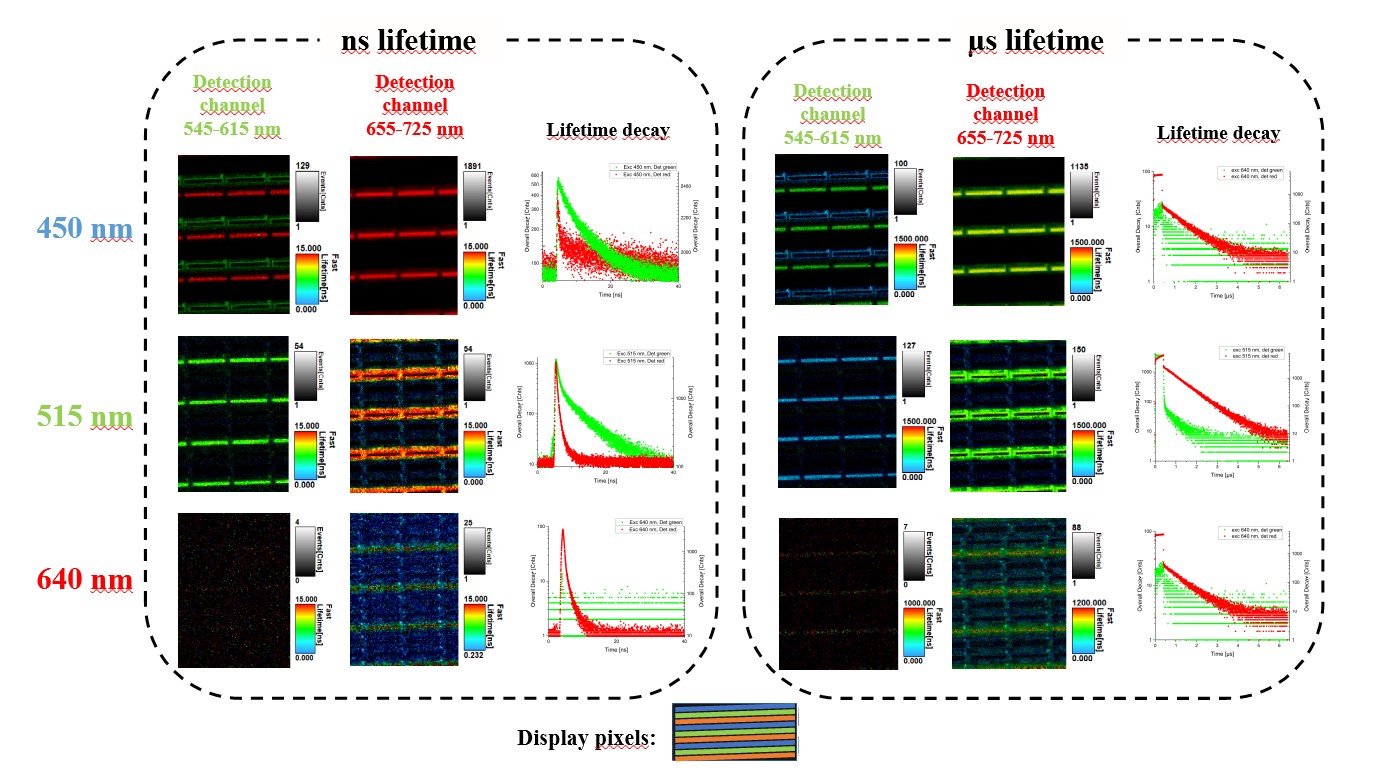 A commercial smartphone display was imaged with the MicroTime 100 time-resolved confocal microscope. Excitation with 450 nm, 515 nm, and 640 nm with the Prima laser was followed by imaging in a green (545 nm to 615 nm) and a red (655 nm to 725 nm) detection channel. The display pixels possess lifetimes both in the ns and µs range. For measuring the ns decays, the Prima laser was set to pulsed mode with 25 MHz repetition rate. For acquiring µs decays, the Prima laser was switched to gated CW mode with 0.4 MHz cycle frequency.
A commercial smartphone display was imaged with the MicroTime 100 time-resolved confocal microscope. Excitation with 450 nm, 515 nm, and 640 nm with the Prima laser was followed by imaging in a green (545 nm to 615 nm) and a red (655 nm to 725 nm) detection channel. The display pixels possess lifetimes both in the ns and µs range. For measuring the ns decays, the Prima laser was set to pulsed mode with 25 MHz repetition rate. For acquiring µs decays, the Prima laser was switched to gated CW mode with 0.4 MHz cycle frequency.
Download the poster to learn more: Photoluminescence studies
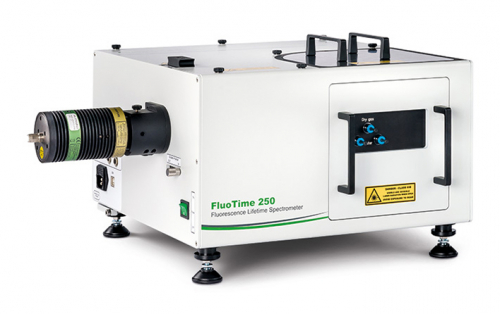 PicoQuant solutions to investigate LEDs and OLEDs :
PicoQuant solutions to investigate LEDs and OLEDs :
- Micro-photoluminescence Upgrade - Microscope-spectrometer coupling >
- FluoTime 300 - High-End Photoluminescence Spectrometer >
- FluoTime 250 - Compact Lifetime Fluorometer >
- MicroTime 100 - Compact Upright Photoluminescence Microscope >
- FluoMic - Compact Upright Widefield Photoluminescence Microscope >
- MicroTime 200 - Confocal Microscopic Platform >
- Wavelength Selection Unit FlexLambda >
QLEDs
QLEDs (Quantum dot-based LEDs) have made significant advancements in the display and lighting industries, offering improved color accuracy, efficiency, and overall picture quality. They function based on a sandwich-like structure. The core of the QLED contains a blue or ultraviolet LED, which emits high-energy light. Surrounding this core are layers of quantum dots. When the high-energy light from the core excites the quantum dots, they re-emit light at specific, desired colors, providing a wider color gamut and more vibrant colors.
The radiative recombination of charge carriers is a critical factor in the efficiency of LEDs. Maximizing the efficiency of this process is essential for creating energy-efficient, bright, and high-quality LED light sources. Efforts to improve the efficiency of radiative recombination in LEDs involve optimizing the design and materials used in LED structures and minimizing non-radiative recombination processes.
Decay dynamics show recombination mechanisms of inter-band and surface states
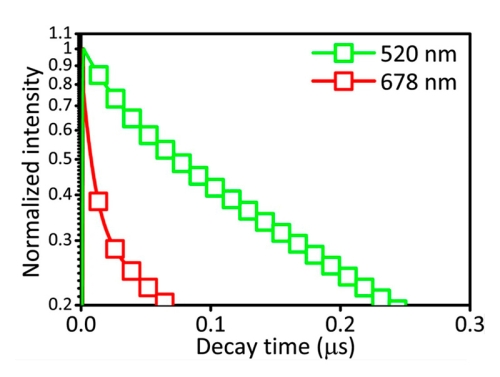 Magic-sized QDs, which consist of specific number of atoms due to high thermodynamic stability, exhibit a high surface to volume ratio, which leads to a high density of trap-states on the surface. In general, trap-states in QDs are not desirable. However, on magic-sized CdSe QDs, they provide white surface-state emission.
Magic-sized QDs, which consist of specific number of atoms due to high thermodynamic stability, exhibit a high surface to volume ratio, which leads to a high density of trap-states on the surface. In general, trap-states in QDs are not desirable. However, on magic-sized CdSe QDs, they provide white surface-state emission.
To study the dynamics of radiative recombination associated with inter-band and surface-state transitions, TRPL measurements were performed by the group of Prof. Sedat Nizamoglu with a MicroTime 100 time-resolved confocal microscope featuring 375 nm excitation. The photoluminescence peak at 520 nm corresponds to inter-band recombination and the peak at 678 nm to the surface-state recombination. PL decay curves obtained at both wavelengths were fitted with a bi-exponential decay model, which revealed a significantly longer lifetime of the surface state emission due to trapped charge carriers.
To learn more, read the paper in Scientific Reports (2019): Efficient White LEDs Using Liquid-state Magic-sized CdSe Quantum Dots
Decay dynamics show decreased energy transfer losses for thicker shells
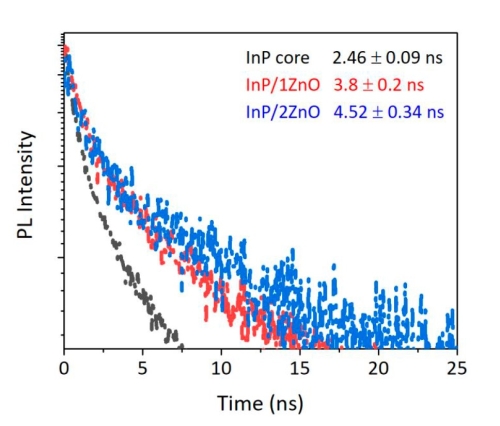 So far, the most well-understood and optimized QDs for LED applications are cadmium-based. However, cadmium (Cd) is a highly toxic metal. To replace Cd-based QDs in LEDs, InP is a promising candidate, due to its high quantum yield and tunable band-gap.
So far, the most well-understood and optimized QDs for LED applications are cadmium-based. However, cadmium (Cd) is a highly toxic metal. To replace Cd-based QDs in LEDs, InP is a promising candidate, due to its high quantum yield and tunable band-gap.
Karatum et al. investigated, QDs with an InP core, surrounded by one or two monolayers of ZnO shell. PL decays of solid films were recorded with a MicroTime 100 time-resolved confocal microscope featuring 375 nm excitation. The shell decreases energy transfer among neighboring QDs, as can be seen from the increased PL lifetimes compared to the InP core alone, thus reducing losses.
To learn more, read the paper in ACS Photonics (2019): Light-Emitting Devices Based on Type-II InP/ZnO Quantum Dots
 PicoQuant solutions to investigate LEDs and OLEDs :
PicoQuant solutions to investigate LEDs and OLEDs :
- Micro-photoluminescence Upgrade - Microscope-spectrometer coupling >
- FluoTime 300 - High-End Photoluminescence Spectrometer >
- FluoTime 250 - Compact Lifetime Fluorometer >
- MicroTime 100 - Compact Upright Photoluminescence Microscope >
- FluoMic - Compact Upright Widefield Photoluminescence Microscope >
- MicroTime 200 - Confocal Microscopic Platform >
- Wavelength Selection Unit FlexLambda >
Perovskite LEDs
Research in perovskite LEDs is advancing rapidly. Perovskite LEDs are known for their excellent color purity. They can emit vibrant and highly saturated colors. The tunable bandgap of perovskite materials allows for precise control over the emitted light's color, enabling a wide range of colors and efficient generation of white light.
Perovskite materials can degrade when exposed to moisture and oxygen. Developing stable perovskite LEDs is an ongoing research challenge. While perovskites have the potential for cost-effective manufacturing, achieving high manufacturing consistency and quality control in perovskite LED production is a significant challenge.
TRPL spectroscopy reveals impact of passivating agents
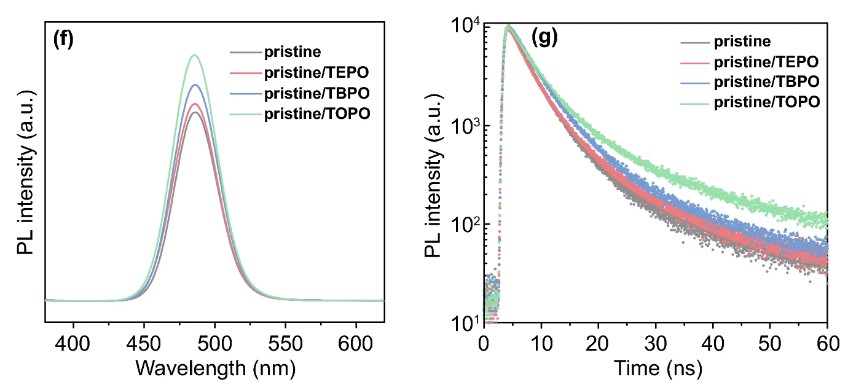 Quasi-2D perovskites are receiving attention as efficient luminescent materials for high performance blue LEDs. The choice of passivating agents should balance carrier confinement within the perovskites with carrier transfer.
Quasi-2D perovskites are receiving attention as efficient luminescent materials for high performance blue LEDs. The choice of passivating agents should balance carrier confinement within the perovskites with carrier transfer.
Here, the passivating agents TEPO, TBPO, or TOPO were tested. Their effect on the perovskite film carrier lifetime was investigated by TRPL spectroscopy with a FluoTime 300 time-resolved fluorescence spectrometer featuring a pulsed 360 nm excitation laser. TRPL decay curves were fitted with a biexponential decay, with the fast component corresponding to trap-assisted nonradiative recombination, and the slow component belonging to radiative recombination. PL lifetimes increase when TEPO, TBPO, or TOPO is added, indicating a reduction of perovskite defects.
To learn more, read the paper published in Advanced Materials (2020): High-Performance Blue Quasi-2D Perovskite Light-Emitting Diodes via Balanced Carrier Confinement and Transfer
Decay curves reveal different effects of spin coating and modified bar coating
Controlling the process of polycrystalline film formation for manufacturing uniform large-area LEDs is challenging. Here, the strategy of separating crystallization of perovskites from film formation was explored, using colloidal perovskite nanocrystals (PNCs). The pre-crystallized PNCs with organic ligands were either spin-coated or modified bar-coated to fabricate uniform films. The photophysical properties of the resulting PNC films were characterized with steady-state and time-resolved PL spectroscopy using a FluoTime 300 time-resolved spectrometer and compared to those of polycrystalline films. Pronounced differences between both coating methods are visible in PL emission spectra and decay curves, the latter indicating different radiative and non-radiative carrier recombination rates.
To learn more, read the paper in Nature Nanotechnology (2022): Exploiting the full advantages of colloidal perovskite nanocrystals for large-area efficient light-emitting diodes
 PicoQuant solutions to investigate LEDs and OLEDs :
PicoQuant solutions to investigate LEDs and OLEDs :
- Micro-photoluminescence Upgrade - Microscope-spectrometer coupling >
- FluoTime 300 - High-End Photoluminescence Spectrometer >
- FluoTime 250 - Compact Lifetime Fluorometer >
- MicroTime 100 - Compact Upright Photoluminescence Microscope >
- FluoMic - Compact Upright Widefield Photoluminescence Microscope >
- MicroTime 200 - Confocal Microscopic Platform >
- Wavelength Selection Unit FlexLambda >

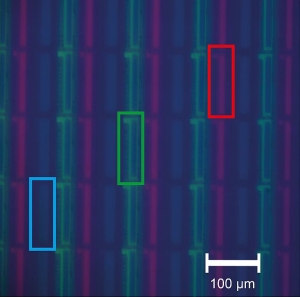
 Contact us
Contact us